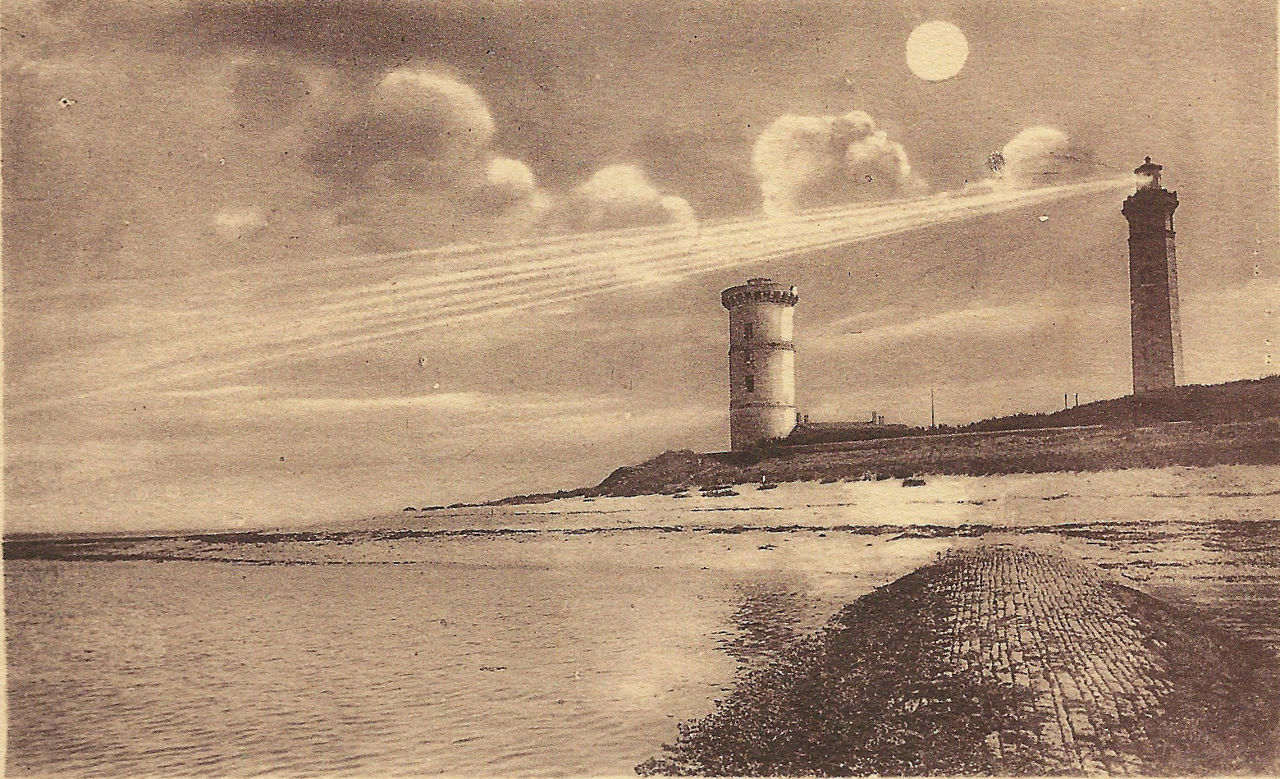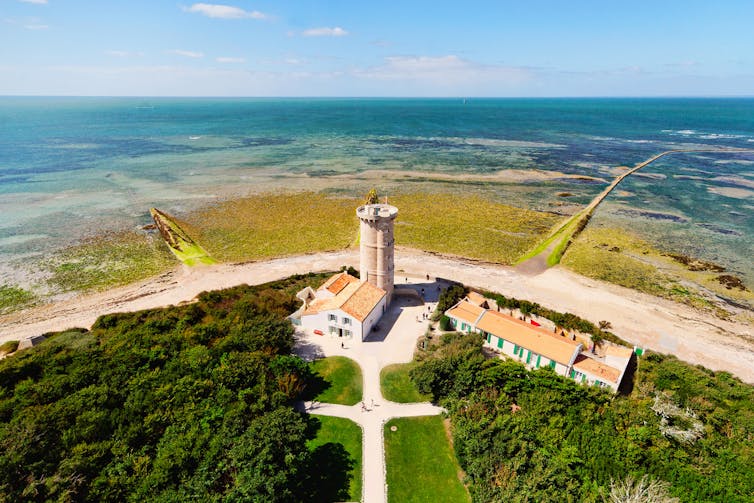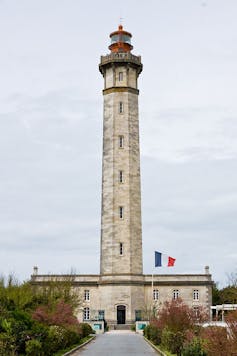The Whale Lighthouse on Île de Ré, a reminder of energy transitions
Every summer, the population of Île de Ré, which is just over 17,000 in winter, increases tenfold. Vacationers flock to the beaches along the coast and the approximately 110 km of bike paths.
Christian de Perthuis, Paris Dauphine University – PSL and Boris Solier, University of Montpellier

One of the must-do activities during your vacation is a visit to the Phare des Baleines lighthouse. Located at the northwestern tip of the island, the building was named after the whales that used to wash up on the beach below.
From its height of 57 meters, this structure offers a unique panorama to the daring souls who climb the 257 steps leading to the top. Its history is also one of multiple innovations that have made it possible to project light ever further.
The Phare des Baleines lighthouse is therefore an excellent indicator of past energy transitions, as analyzed in a recent study by the Climate Economics Chair.
From whale oil to electrification
The story begins under Louis XIV. The construction of the Baleines tower, located between the current lighthouse and the coastline, was commissioned by Colbert, then Secretary of State for the Navy, and completed in 1682 under the supervision of Vauban.
The tower originally burned fish and whale oil, which provided poor lighting and was inefficient, as the burning oil tended to calcine the lantern's glass. Whale oil was the fuel of choice at the time, and the world's demand for lighting dangerously accelerated the hunting of this marine mammal, which is now protected.

Ludovic/Flickr, CC BY-SA
In 1736, coal replaced whale oil as fuel. It was burned in a stove topped with a dome to reflect the light. This change improved lighting efficiency but required the transport of large quantities of coal. The archives of the Cordouan lighthouse, located at the mouth of the Gironde, reveal that the keepers had to carry between 100 and 150 kg of coal up to the lighthouse every day to feed the fire. This is why coal was subsequently replaced by lamp oil, before switching to electricity at the beginning ofthe 20th century.
The transition from whale oil to coal improved lighting power. For an equivalent mass, the calorific value of coal, i.e., the amount of energy produced when it is burned, is much higher than that of whale oil. Similarly, the substitution of petroleum for coal subsequently increased lighting efficiency.
The mobilization of primary sources with increasingly dense energy content is one of the major characteristics of the energy transitions analyzed by Vaclav Smil. Using a historical approach, the author shows that this densification has led to an unprecedented increase in global energy consumption and fossil fuelCO2 emissions.
The leverage of efficiency gains
In addition to improvements in the energy sources used by lighthouses, innovations were made in energy conversion and light diffusion techniques, first with the invention of the Fresnel lens by French engineer Augustin Fresnel (1822), then with the invention of the electric light bulb by Joseph Swann (1878) and Thomas Edison (1879).
The old Baleines tower, whose range was deemed insufficient, was replaced in 1854 by the current lighthouse, which is twice as high. It was one of the first to benefit from the Fresnel lens system, still in use today, enabling it to reach a range of approximately 50 km.

Jean-Christophe Benoist/Wikimedia, CC BY
In 1904, a steam-powered electricity generator replaced the previous combustion systems. The Phare des Baleines lighthouse was not connected to the electricity grid until the 1950s. With electricity, the lighthouse's range was once again increased thanks to the efficiency of light bulbs in converting energy into light.
Technical advances in converting energy into light were even more decisive in increasing the range of lighthouses than the increase in the quantity and quality of the primary energy used. This echoes the conclusions of Fouquet and Pearson's work, which shows the major role played by efficiency gains in reducing lighting costs over the past two centuries.
A more general lesson for energy transitions: as much as the mix of energy sources, which is often the focus of debate, the chain of transformation of these sources into end uses is a crucial link in energy systems and their transformations.
From light to satellites
The etymology of the word "lighthouse" comes from the Greek word Pharos, named after the island where the famous Lighthouse of Alexandria stood, which disappeared over 700 years ago. While modern lighthouses have not disappeared, most of them are classified as historical monuments, as their operation, uses, and usefulness have changed significantly since they were built.
The arrival of electricity initially paved the way for the automation of lighthouses. The last keeper of the Baleines lighthouse left in the early 2000s, when its operation was fully automated.
Advances in satellite-assisted navigation, which is now standard equipment on most boats, have drastically reduced the usefulness of lighthouses, to the point that some are now up for sale. The Phare des Baleines lighthouse will certainly continue to sweep the ocean with its beams of light for a long time to come, even if its original purpose, guiding navigation, is now somewhat obsolete.
As visitors descend the 257 steps of the lighthouse, they are bound to wonder about the current energy transition. Has the shift from lighthouses to satellites for guiding ships reduced fossil fuel consumption and, as a result,CO2 emissions?
It is probably the opposite: the primary energy used by information technologies is not directly visible in the same way as whale oil or coal hoisted to the top of old lighthouses. But it is high because satellite imagery involves a whole infrastructure that consumes gray energy. Above all, satellite guidance makes it possible to multiply end uses and contributes to the very rapid growth of maritime navigation: one of the sources of CO2 which is growing the fastest in the world!![]()
Christian de Perthuis, Professor of Economics, founder of the Climate Economics Chair, Paris Dauphine University – PSL and Boris Solier, Senior Lecturer in Economics, Associate Researcher at the Climate Economics Chair (Paris-Dauphine), University of Montpellier
The original version of this article was published on The Conversation.